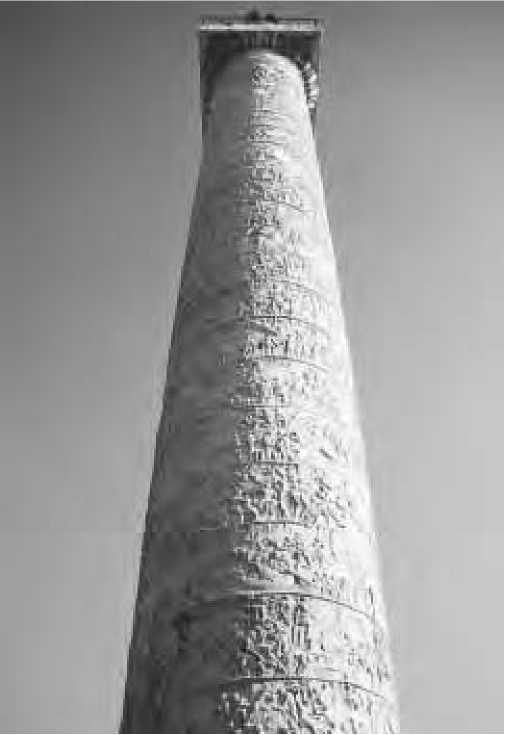Placed in the Campus Martius; a monument that adhered closely to Antoninus’s firm belief in the preservation of classicism in art.
Column of Marcus Aurelius
Dedicated in 193 c. e. and built by order of the emperor’s son, COMMODUS, the column was placed in what is now the Piazza Colonna. It resembled very closely the Column of Trajan, although its base is considered to be better proportioned. Like Trajan’s monument, the column was carved with a series of magnificent reliefs spiraling along the shaft and depicting the wars raging along the Danube from 167 to 179. The battles grimly represented involved hardship and blood, with fallen legionaries alongside barbarians. The story of the “Miracle Rain” was carved into the column, the thunderstorms that proved to be so providential and beneficial to the Romans during one of these battles. Marcus himself appeared in the same harsh, somber relief as the rest of the figures. The monument came to be known as the Antonine Column. The column’s base was repaired in 1589 C. E.
Comana (1) Town in Cappadocia whose importance derived from its temples and the power of its high priests. These clerics ruled land and faithful, but the town attracted merchants and markets. In time the influx of new people helped break the priests’ hold, and under VESPASIAN, Comana received a charter as part of a province.
Comana (2) City in the kingdom of pontus. Comana was the seat of the state religion, and the high priest there exercised considerable power. The strength of the religion faded after Pontus was annexed by Rome in the reign of Augustus (27 B. C.E.-14 c. e.).

Trajan's Column (Courtesy Fr. Felix Just, S. J.)
Comes Title given to a high-ranking military or administrative figure in the late empire. As the court developed in size and in influence, the emperors established a casual practice of appointing loyal servants to various posts. This process has already been utilized elsewhere, as with the PREFECT OF THE PRAETORIAN GUARD and the AMICI PRINCIPIS. As the imperial system expanded, however, new offices were needed and centralization demanded change. The result was the creation of the rank of “comes” or count.
The comites (counts) became the leading officials of the Roman Empire. They wielded posts of every description, from the army to the civil service, while never surrendering their direct links and access to the emperors. Constantine took the final step of certifying the posts so that they were permanent fixtures of imperial government. The following is a list of the various types of comes:
Comes Africae Count in charge of the defense of Roman Africa.
Comes Avernorum Count in charge of the defenses of part of Gaul (gallia).
Comes Britanniarum Count in charge of the defense of Roman Britain (brittania). This post presumably died out circa 410 C. E., when the last Romans in the isles sailed away forever.
Comes dispositionum A deputy to the very powerful MAGISTER OFFICIORUM (master of offices); responsible for organizing the imperial calendar and preparing the correspondence for distribution to the proper offices for transcription.
Comes domesticorum Head of the DOMESTICI, the imperial bodyguards of the emperor who were stationed in the palace. This count controlled both the horse and foot units.
Comes Hispaniarum Count in charge of the defense of Roman Spain (hispania).
Comes Orientis Actually a member of the vicarii, this count had control of the large diocese of ORIENS.
Comes privatae largitionis Official in charge of the privy purse, answerable and subordinate to the comes rerum privatarum.
Comes rerum privatarum Powerful imperial official responsible for the private estates or holdings of the emperor and his family (res PRIVATa). The count maintained the properties and collected all money from rent, of which most went to the public funds and some to the privy purse administered by the comes privatae largitionis.
Comes sacrarum largitionum Master of the sacred Largesse, this count operated the imperial finances. He controlled all of the mints, collected senatorial taxes, custom duties, and some of the land taxes. He was also responsible for the yields of mines. The count provided budgets for the civil service and armies and supplied all uniforms.
See also finance; fiscus; rationalis; and RATIONIBUS, A.
Comes sacrae vestis Count in charge of the wardrobe of the emperor.
See also praepositus sacri cubiculi.
Comitatenses One of the divisions of the army of the Late Roman Empire, forming a strong mobile force at the disposal of the emperor. in effect, these were field troops, as compared to the limitanei and palatini, the border and bodyguards respectively. For a detailed examination, see LEGIONS.
Comitates Names given to the retinue of the emperor when he was in the field. These were the troops who actually accompanied the ruler on military campaigns. service was distinctly more enjoyable than that on the frontiers. Composition of the comitates came from the COMITATENSES.
See also legions.
Comites See comes.
Comitia Tributa Venerable Republican institution empowered for centuries with the right to elect magistrates and to pass laws. It remained in existence into the imperial age but lost influence with the increasing authority of the emperors and eventually ceased to exist.
Commagene Small Euphrates-based kingdom of Seleucid origin, located between Armenia and Cilicia. Commagene survived the fall of the Seleucids in Syria and came to the attention of Rome in 63 B. C.E., when POMPEY THE GREAT reorganized the East. Antiochus I, the ruler of Commagene, was allowed to remain on the throne as a buffer between the Parthians and the Romans. His position, however, drew his kingdom into the wider conflict between those powers. Antiochus leaned toward PARTHIA, and in 36 B. C.E., during Marc Antony’s ill-fated campaign, he gave aid to the retreating Parthians. Anti-ochus was thus deposed by the Romans in favor of his brother, Mithridates II.
Roman influence in the kingdom grew over the next decades. Mithridates and another notable monarch, Antiochus III, reigned over a troubled land as parties both internally and externally called for imperial annexation. In 17 C. E., Antiochus III died, and Commagene was placed under the control of praetors by Emperor Tiberius —Quintus Servius being the first. In 37 C. E., gaius CALIGULA returned the realm to its rightful claimants. Antiochus IV received back his kingdom, to which was added parts of Cilicia and Lycaonia, plus the sum of 100 million sesterces. Caligula proved an unreliable patron. In 40 he expelled the cruel Antiochus, not out of disappointment with his rule (he liked him) but because he wanted his money back. Claudius reinstated Antiochus, and the entire kingdom supported Rome in its next war against Parthia in 57. Emperor Vespasian decided to return to Tiberius’s policies toward Commagene. In 72, he annexed small domains in the region and Commagene was among them. It was attached to the province of SYRIA.
Commius (fl. first century b. c.e.) King of the Trebates, the Belgic tribe also called Atrebates
Commius owed his kingship to Julius caesar and was, for as long as possible, his trusted ally. The Belgae had both communications and colonies in Britain, a fact not lost on Caesar as he planned his expedition to the isles in 55 b. c.e. Commius received a request to sail across the Channel to encourage the local British tribes to submit peacefully to Rome. His mission was a disaster, however, and Commius found himself imprisoned by the tribes in the region of Kent. Caesar landed, fought and won a few victories before Commius was released. He returned to his own land.
Much of Gaul planned to revolt against Rome. Com-mius joined the organizers, intending to bring with him the entire nation of Gallia Belgica. Labienus, Caesar’s able lieutenant, discovered the plot and tried to remove Commius through murder. The Roman assassination failed, but Commius suffered a grievous injury, which aborted the involvement of his people in the uprising. Following the conclusion of the Gallic revolt, circa 51 B. C.E., Caesar aided a Belgic warlord, Correus, in stirring up dissent among the tribes of Gallia Belgica, although Correus is best known for his later opposition to Caesar. He died in an ambush during a revolt of the Bel-loraci. Caesar moved quickly against them, forcing Com-mius to settle with his old Roman ally. By 50 B. C.E. Commius was resolved to leave the land of Roman occupation. Commius sailed across the Channel again, this time as a free king in search of a domain. Commius settled near the Thames River and founded a dynasty in southern Britain, in coordination with the other Celtic tribes already there.
Commodian (fl. third century c. e.) Christian poet Commodian authored two long poems, in loosely written hexameters but varying in quality and in accent. He probably came from Gaza and was a convert to Christianity, accepting the faith with great fanaticism.
Commodus (Marcus Aurelius Commodus Antoninus) (161-192 C. E.) Emperor from 180 to 192 c. e. Aurelius Commodus proved to be an unworthy successor to his illustrious father, Marcus aurelius. Born at Lanu-vium as one of a pair of twins to Faustina (his brother died in 165), he was named Commodus after the original name of his adoptive uncle Lucius Verus. His education was the finest available for an imperial heir and, beginning in 166, Marcus Aurelius groomed him for the throne. In that year he was made Caesar (junior emperor), 10 years later imperator and in 177, Augustus (coruler of the empire).
From 177 to 180, Commodus studied under his father the art of statecraft in the field. Marcus Aurelius was managing the mammoth affairs of the empire while conducting a war with the Marcomanni on the Danube. The aged emperor’s health finally collapsed, however, and on March 17, 180, Commodus succeeded to the throne at Vienna. At only 19, the new ruler at first wisely listened to the advisers of his late father but then started to give in to the flattery and intrigue of those courtiers who wanted to abandon the campaign and return home. The result was Commodus’s first major, independent decision. He suspended the war along the Danube, which also meant that Rome’s territorial ambitions had to be curbed. Commodus opted for a triumphal entry into Rome. Despite the pleas of his father’s counselors, he returned to the capital, buying off the Marcomanni and other Germanic tribes with tributes and concessions, a policy that proved successful for a time.

A coin from the reign of Commodus; on the obverse side is a testament to Britannia. (Hulton/GettyArchive)
Shortly after his arrival in Rome, Commodus uncovered supposed plots against him, all hatched within the palace and even within his own family. His sister, Annia Lucilla, her cousin, Ummidius Quadratus, and her nephew-in-law, Quintianus, were all accused of conspiracy. Quadratus and Quintianus died immediately. Lucilla was exiled to Capri and later executed. Commodus was not satisfied with these deaths and became convinced that one of his two prefects of the praetorian guard, Tarrutenius Paternus, had also been a member of the conspiracy. Paternus joined the others in death.
The trend of Commodus’s reign was set with Pater-nus’s fall, for the successor in his power and rank was Tigidius perennis, who had been his coprefect. Perennis was the first of several court officials who would gain considerable influence over the unstable emperor. Peren-nis allowed his master to indulge his taste for games and suspicion while he ran the empire virtually unchallenged. His sons received posts in Pannonia, while the prefect himself came to be hated by his court rivals. Inevitably he perished, in 185, along with his sons.
Marcus Aurelius cleander followed him in imperial favor. A freedman, Cleander outmaneuvered his fellow prefects and tried to elevate himself even further by hoarding imperial grain. Riots broke out in Rome, and an indication of Commodus’s casual rule was demonstrated by his near total ignorance of the city’s upheavals. Alerted finally by his sister, Phadilla, his response was simple. He cut off Cleander’s head and gave it to the crowd on a stick. Following Cleander’s decapitation in 186, Aemilius Laetus took control of the Guard and watched Com-modus deteriorate steadily. Dio called him a greater curse upon the Romans than any plague, and the Senate especially felt his hatred and suspicions. Commodus killed its members and seized their property at every opportunity, extorting money in return for keeping accused persons alive. The imperial treasury was being drained, and he found extreme means of refilling his purse.
He loved games of every sort and once ran 30 races in two hours. His true passion, however, was for gladiatorial exhibitions and athletic prowess. Animals of every description were slaughtered in groups; his excesses culminating in a 14-day bloodbath of races, gladiators, and massacres. For Commodus the games were a great personal triumph, fostering his own belief in his superiority.
Commodus believed himself to be Hercules reincarnated and a fighter worthy of heroic legend. Rome was renamed Commodianus, and the legions became known as Commodian. Another plot was formed against Com-modus as a result. This time Laetus and the Chamberlain Eclectus were involved. Buoyed by Commodus’s declaration that at his inauguration as consul on January 1, 193, he would march in full gladiatorial costume (he normally wore a lion skin and carried a club), even his concubine, Marcia, joined in the plot. They attempted to poison him but he showed every indication of surviving that attack. A wrestling companion was then brought to him to put an end to his life and reign. The companion, Narcissus, strangled Commodus in his bath on the night of January 31, 192.
The main historical event of his reign took place in Britain, where, in 184, the Antonine Wall was breached by the Caledonians. ulpius Marcellus had to campaign three times in order to evict the invaders. Commodus’s body was placed in the mausoleum of Hadrian as the Senate greeted the news of his death with glee. The first natural heir to succeed to the throne, Commodus bequeathed chaos to coming generations. Pertinax followed him as emperor, but only a short time later the empire would be auctioned off to the highest bidder.
Communication See cursus publicus, mansiones,
TRANSPORTATION, VIA; see also LITERATURE and WRITING INSTRUMENTS.
Concilia The councils (singular, concilium) of each province, established to keep Rome informed of regional needs and problems and to propagate the cult of Rome and the emperors. under the Republic the occupied territories had no voice with which to express opinions or complaints, except for infrequent and ineffective delegations of local officials. The first emperor, Augustus, desired channels of communication with the provinces when his reign began (27 B. C.E.). He took steps to ensure that most provinces possessed a board or congress of some sort, and the result was the concilia.
The concilia fulfilled two major functions. Augustus believed that the empire should be efficient, yet allow a certain amount of native self-expression in a given region, coupled with participation in the grand imperial framework of events and policies. The concilia in each territory provided both the voice of the province and the means by which the imperial cult could be fostered.
The concilia (or koina in the East) were not wholly new. They had existed in some form in various kingdoms of Asia Minor, and even Julius Caesar had summoned notable tribal chiefs to participate in a conference in Gaul. In the West, however, the form of councils was less known and hence more malleable to Roman influence.
One of the first concilia in the West originated in 12 B. C.E. in Gallia Comata. By the time Vespasian ruled the Roman world (69-79 B. C.E.), all of the various parts of the empire had councils. Exceptions to this were Egypt and those groups of provinces (such as in Gaul) where one congress represented a broad stretch of interests and concerns along racial or cultural lines, rather than political ones.
Delegates from each city traveled to a major center and elected its concilium and an officer to serve as president. The council head administered secular affairs and directed the annual grand festival, with games, in honor of Rome and the emperor. Regular business would also be conducted and dispatches to Rome drafted. Such dispatches proved invaluable in the first century C. E. in providing an accurate assessment of the provinces. Also, governors found themselves suddenly answerable to the Senate and the emperor for administering affairs incorrectly or harshly In 23 C. E., for example, Lucilius Capito, procurator of Asia, was accused and tried for overstepping his authority The concilia lacked basic powers, however. The members could not enact legislation and relied upon imperial goodwill in all matters. When the emperor became isolated or absent, as in years of crisis, the role of the concilia declined.




 World History
World History









